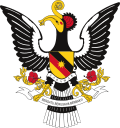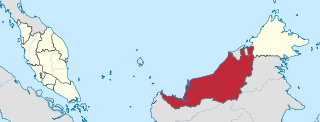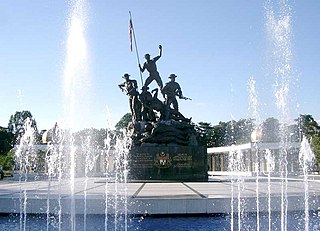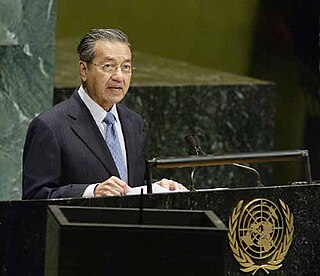| Chief Minister of Sarawak Ketua Menteri Sarawak | |
|---|---|
 | |
| Government of Sarawak | |
| Style | Yang Amat Berhormat (Right Honourable) |
| Member of | Sarawak State Executive Council |
| Reports to | Sarawak State Legislative Assembly |
| Residence | Astana, Demak Jaya, Sarawak |
| Seat | Tingkat 22, Wisma Bapa Malaysia, Petra Jaya, 93502 Kuching, Sarawak |
| Appointer | Abdul Taib Mahmud as Yang di-Pertua Negeri of Sarawak |
| Term length | While commanding the confidence of the Sarawak State Legislative Assembly With State Elections held no more than five years apart |
| Constituting instrument | Constitution of the State of Sarawak |
| Inaugural holder | Stephen Kalong Ningkan |
| Formation | 22 July 1963 |
| Deputy | Douglas Uggah Embas James Jemut Masing Awang Tengah Ali Hasan |
| Website | www |
The Chief Minister of Sarawak is the head of government in the Malaysian state of Sarawak. The Federal Constitution (Art. 2(a), 8th Schedule) [1] and State Constitution (Art. 10(2)(a)) [2] provides that the Yang ii-Pertuan Negeri may, in his discretion, appoint any member of the State Legislative Assembly who, in his judgement, commands the support of a majority of the members of that chamber as Chief Minister [3] . By convention, the Chief Minister is the leader of the majority party or largest coalition party of the Sarawak State Legislative Assembly.
The head of government is either the highest or second highest official in the executive branch of a sovereign state, a federated state, or a self-governing colony, who often presides over a cabinet, a group of ministers or secretaries who lead executive departments. "Head of government" is often differentiated from "head of state", as they may be separate positions, individuals, or roles depending on the country.

Sarawak is a state of Malaysia. The largest among the 13 states, with an area almost equal to that of Peninsular Malaysia, Sarawak is located in northwest Borneo Island, and is bordered by the Malaysian state of Sabah to the northeast, Kalimantan to the south, and Brunei in the north. The capital city, Kuching, is the largest city in Sarawak, the economic centre of the state, and the seat of the Sarawak state government. Other cities and towns in Sarawak include Miri, Sibu, and Bintulu. As of the 2015 census, the population of Sarawak was 2,636,000. Sarawak has an equatorial climate with tropical rainforests and abundant animal and plant species. It has several prominent cave systems at Gunung Mulu National Park. Rajang River is the longest river in Malaysia; Bakun Dam, one of the largest dams in Southeast Asia, is located on one of its tributaries, the Balui River. Mount Murud is the highest point in Sarawak.

The Sarawak State Legislative Assembly is a component of the unicameral legislature of the Malaysian state of Sarawak; the Yang di-Pertuan Negeri of Sarawak forms the other part of the legislature. The Assembly is derived from the traditions of the Westminster parliamentary system, which originates from the practices of the British Parliament. The executive branch of government is drawn from the elected members of the Assembly. The State Legislative Assembly sits at the Sarawak State Legislative Assembly Building located in Petra Jaya in Kuching, the state capital.
Contents
- Appointment
- Powers
- Caretaker Chief Minister
- List of Chief Ministers of Sarawak
- Living former Chief Ministers
- See also
- References
The 6th and current Chief Minister of Sarawak is Abang Abdul Rahman Zohari Abang Openg, who took office on 13 January 2017 [4] [5] .












